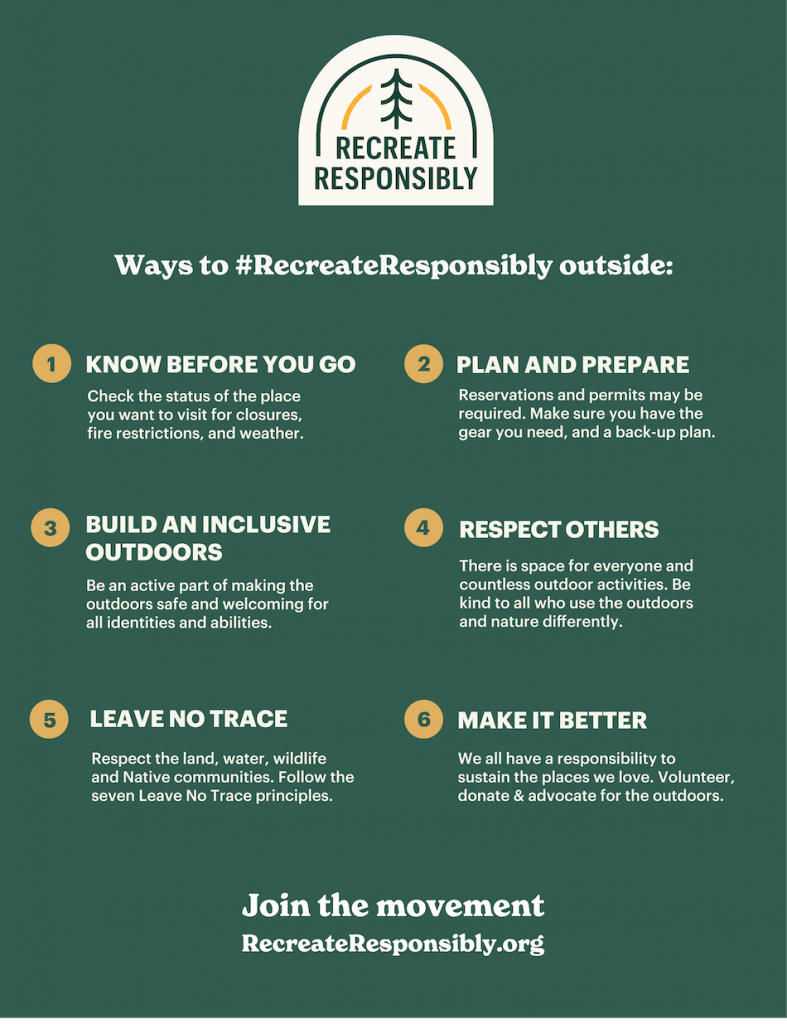There’s no wonder that folks such as John Muir have been preaching the benefits of venturing to the wilderness with its fresh mountain air, views for days, free recreation, wildlife abound, and so much more. While many have been drawn to these attributes for a long while now, an influx of others are discovering the incredible offerings out there. Like anything new, there tends to be a learning curve for figuring how to do things the right way. There’s no exception for recreating. To give you a head-start and ensure that everyone heading outdoors here has a good time, it’s important to recreate responsibly which means following trail etiquette, Leave No Trace, and geotagging responsibly principles.

Trail Etiquette
For the majority in the Wood River Valley, their first and most frequent access to the outdoors is through the area’s vast system of trails for hiking, biking, and horseback riding. With so many users, trail etiquette is of the utmost important to make sure the trails stay pleasant for everyone.
Stay in control
Know your limits, slow down around blind turns, step to the side to let others pass when appropriate. Maintain awareness of your surroundings by keeping music volume low in your earbuds or simply not listening to music while on the trails.
Yielding
Downhill traffic always yields to uphill. Always yield to horses (and give a nice “hello” to help them not spook). Bikers yield to hikers, runners, and horses. However, in many instances, it’s much easier for hikers/runners to yield to bikers, both the pedaling kind and the motorized kind. If you’re on a bike and would like to pass someone, let them know you’re coming up behind them, slow down, and ask to pass. Yield with one foot on ground parallel to the trail; stepping off trail leads to erosion and trail widening. Same goes for hiking and walking—do so single file, not side by side. Downhill bikers should yield to uphill bikers.
Be prepared
Know where you’re going in advance and have a physical map in case cell phones die or go out of service (or a device like a Garmin InReach that works in the backcountry). Bring layers for unpredictable weather and always tell someone where you’re going and when you’ll be back.
Do not use wet or muddy trails
If the trail turns wet or muddy, turn back. You can find out which local trails are open or partially open by visiting the Blaine County Recreation Center’s trailink.
Leave No Trace
Leave No Trace has seven core principles that are meant to guide you in enjoying the wilderness while not leaving your mark. While Leave No Trace has its roots in backcountry settings, in Ketchum, the “backcountry” can be pretty much out your back door, meaning these principles apply everywhere. And while these seven principles are fairly widely known and established, they are not static, but rather constantly being reevaluated and shaped to create the best practices in the outdoors.
1. Plan ahead and prepare
Key takeaways: Plan activities that match your skill and ability level, learn about the area through maps and more (is it private land?), pick clothing and equipment for comfort and safety, consider weather and terrain
2. Travel and camp on durable surfaces
Key takeaways: Avoid damage to land or waterways, always travel on trails (no shortcuts or social trails!). If going off-trail (exploring campsite, taking bathroom breaks, traveling remotely where there are no trails), be mindful of fragile surfaces. Avoid camping close to water and trails, neutralize your campsite when breaking camp.
3. Dispose of waste properly
Key takeaways: Learn what methods are required for disposing of human waste for that area: some areas require you pack it out while others just require it to be buried. If burying waste in what are known as “cat holes,” place at least 200 feet from water, camp, or trails. Make sure hole is at least 6-8 inches deep and cover with natural materials when done. For all other waste, if you pack it in, pack it out! For wastewater, dispose at least 200 feet away from lakes and streams. If using soap to wash dishes, use biodegradable although this can still affect waterways so use soap sparingly. Don’t forget to pick-up your fury friends poop as well!
4. Leave what you find
Key takeaways: Leave natural elements as they are such as rocks, flowers, plants, and other objects of interest so others can enjoy them as well. Leave areas as you found them by not digging trenches for tents. Do not damage trees by carving into them or putting up nails for trash bags.
5. Minimize campfire impacts
Key takeaways: Whenever possible, use a camp stove rather than a fire for cooking. If making a fire, consider whether there is high fire danger for the area, if there are administrative restrictions on fires for the area, if there is enough wood in the area that can be used so as not to make a noticeable impact. Do not use live wood by cutting branches or stripping trees. Pack out plastic or foil rather than burning.
6. Respect wildlife
Key takeaways: Learn about wildlife through quiet observation from a distance. Travel quietly unless in bear country where you are encouraged to make a little noise. Do not feed animals.
7. Be considerate of others
Key takeaways: Respect other people’s experience by minimizing excessive noise, uncontrolled pets, and damaging surroundings.
Geo Tagging Responsibly
“Geo tagging” refers to adding your location when posting photos on apps like Instagram. While we all love to take photos of our beautiful, wild surroundings, adding a specific location that allows others to pull that location up on a map had put certain wild spaces, and those who visit them, in danger. For those spaces, having a specific location means more traffic to an area which might not be ecologically prepared to handle it. People may also see a gorgeous photo and decide to go to the tagged location without knowledge of what kind of equipment and supplies it takes to get there. To reduce traffic and keep people from blindly visiting places they’re unprepared for, use generic tags such as “tag responsibly, keep the west wild,” or other general identifiers.
Check Out Recreate Responsibly Idaho
The State of Idaho has put together a comprehensive set of resources online to reference as needed. It’s a great spot to stay informed with the best practices on a state level.
